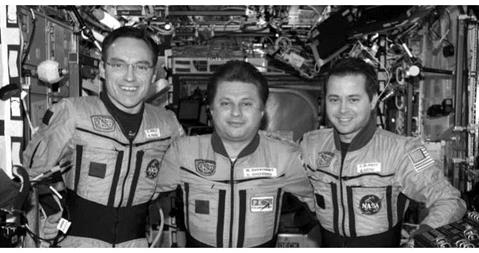ISS EO-4
|
Int. Designation |
N/A (launched on STS-108) |
|
Launched |
5 December 2001 |
|
Launch Site |
Pad 39B, Kennedy Space Center, Florida |
|
Landed |
19 June 2002 (aboard STS-111) |
|
Landing Site |
Edwards AFB, California |
|
Launch Vehicle |
STS-108 |
|
Duration |
195 days 19hrs 38 min 12 sec |
|
Call sign |
Skif (Scythian) |
|
Objective |
ISS-4 expedition programme |
Flight Crew
ONUFRIYENKO, Yuri Ivanovich, 40, Russian Air Force, ISS-4 and Soyuz TM commander, 2nd mission Previous mission: Soyuz TM23 (1996)
BURSCH, Daniel Wheeler, 44, USN, ISS-4 flight engineer 1, 4th mission Previous missions: STS-51 (1993); STS-68 (1994); STS-77 (1996)
WALZ, Carl Erwin, 46, USAF, ISS-4 flight engineer 2, 4th mission Previous missions: STS-51 (1993); STS-65 (1994); STS-79 (1996)
Flight Log
The fourth expedition featured an experiment programme of 26 US and 28 Russian experiments in the fields of bioastronautics research, physical sciences, space product development, fundamental space biology, Earth observations, education and technology. Many of these experiments were carried over from previous expeditions.
During their stay aboard the station, the crew performed three EVAs. The first two (14 Jan for 6 hours 3 minutes and 25 Jan for 5 hours 59 minutes) were conducted from the Pirs facility on the Russian segment. The final one (20 Feb for 5 hours 47 minutes) was conducted out of the Quest airlock on the American segment. During the first EVA, Onufriyenko and Walz relocated the cargo boom for the Strela crane from PMA-1 to the outside of Pirs. An amateur radio antenna was also installed on Zvezda. EVA-2 saw Onufriyenko and Bursch install six deflector shields on the Service Module thrusters, install a further antenna and retrieve various science packages from Zvezda. The final EVA was conducted by the two American members of the ISS-4 crew on the 40th anniversary of the first flight of John Glenn, the first American to orbit the Earth. Walz and Bursch performed the EVA from the Quest airlock, the first without a docked Shuttle in support. The objective was to prepare the area for installation of the S0 Truss during STS-110 in April 2002, relocating the tools to be used and inspecting the exterior of the station.
|
The ISS-4 inside the US Destiny lab. L to r Walz, Onufriyenko, Bursch |
During the mission, the crew would oversee the upgrading of software as well as receiving the Progress Ml-8 re-supply craft. Their visitors arrived on the STS-110 mission that delivered the S0 Truss assembly and on the Soyuz TM33 Taxi mission. Prior to the arrival of Soyuz TM34, the crew had to relocate TM33 from the nadir port of Zarya to redock with the Pirs docking port.
The crew experienced several power problems and a number of failures of the Elektron oxygen generator. To conserve oxygen reserves in the tanks of Quest, the crew resorted to burning solid fuel oxygen generators in the Zvezda module while they attempted repairs to Elektron. This took several days during May. They also experienced difficulties with the operation of the Canadarm2, including the failure of the wrist roll joint, which would require replacement.
They were relieved on the station in June by the ISS-5, who arrived on STS-111, the mission that would take the ISS-4 crew back to Earth. Both the Americans in the ISS-4 crew surpassed Shannon Lucid’s previous US space flight endurance record (188 days), eventually clocking 196 days. In their careers, both men had flown four times and by the end of their ISS mission, Walz had logged 231 days in space while Bursch had accumulated 227 days. Onufriyenko had also completed two long missions and brought his experience to 389 days by the end of this one.
Milestones
4th ISS resident crew
3rd ISS EO crew to be launched by Shuttle
1st EVA from Quest without a Shuttle docked to the station











